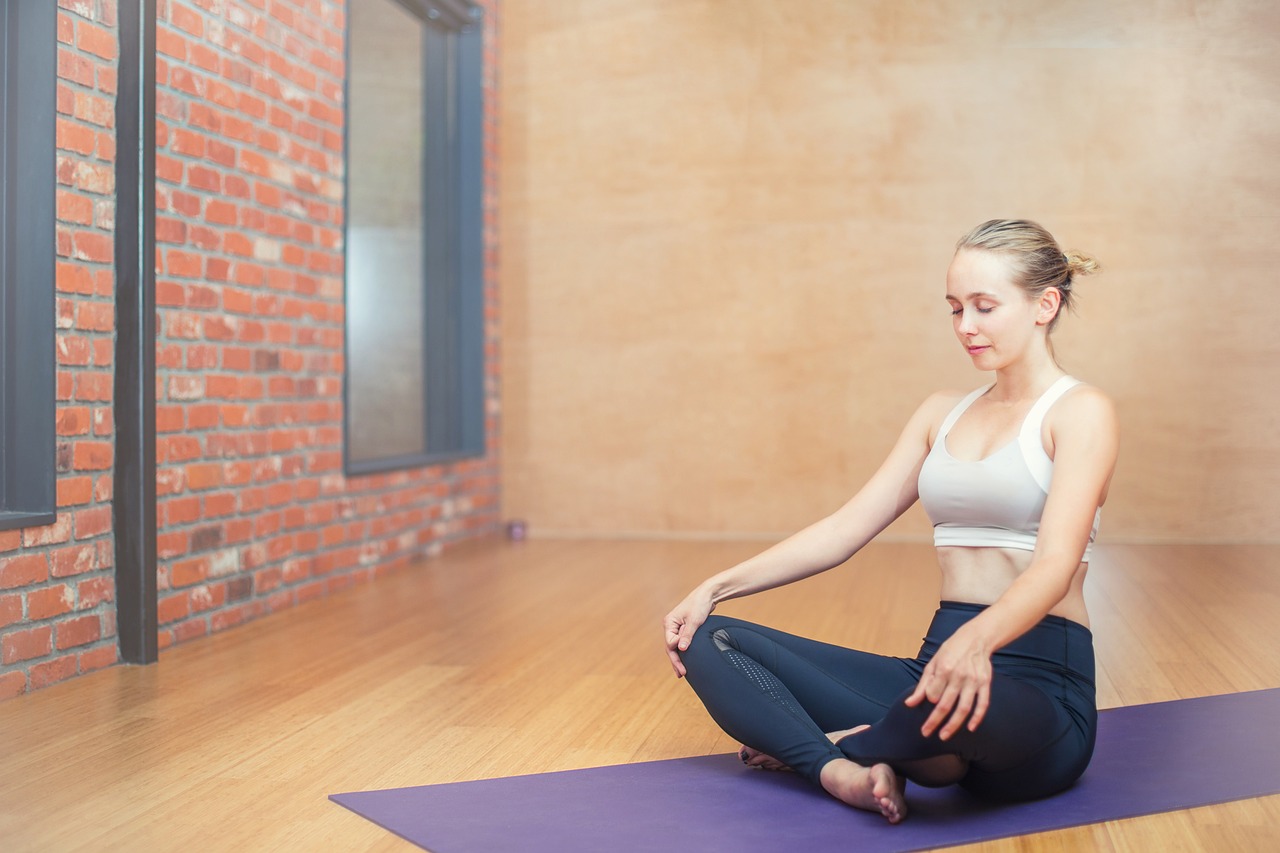Are you feeling overwhelmed by the chaos and stress of everyday life? If so, meditation might be just what you need to find some inner calm. In this article, we will walk you through a step-by-step guide to meditation for beginners. Whether you’re new to the practice or just looking for some guidance, this comprehensive guide will help you tap into the power of meditation and discover a sense of peace and tranquility within yourself. So, clear your mind, find a comfortable spot, and get ready to embark on a journey of self-discovery and serenity.

Table of Contents
What is Meditation?
Meditation is a practice that has been around for centuries and is widely known for its ability to bring a sense of calm and peace to the mind and body. It is a technique that involves focusing your attention and eliminating the stream of thoughts that may be crowding your mind. By engaging in meditation, you can achieve a deep state of relaxation and develop a greater sense of self-awareness.
Types of Meditation
There are various types of meditation that you can explore, each with its own unique approach and benefits. Some popular types of meditation include:
- Mindfulness Meditation: This type of meditation focuses on being fully present in the moment, observing your thoughts and sensations without judgment.
- Loving-Kindness Meditation: Also known as Metta meditation, this practice involves cultivating feelings of love, compassion, and kindness towards yourself and others.
- Mantra Meditation: In this form of meditation, you repeat a particular word or phrase (mantra) to help focus and quiet the mind.
- Guided Imagery Meditation: This practice involves visualizing calming scenes or images to bring about a sense of relaxation and mental clarity.
- Body Scan Meditation: With body scan meditation, you bring your attention to different parts of your body, gradually releasing tension and promoting relaxation.
Benefits of Meditation
The benefits of meditation are numerous and can have a significant impact on your overall well-being. Regular meditation practice has been shown to:
- Reduce stress and anxiety: By promoting a state of relaxation, meditation can help calm the mind and reduce stress levels.
- Improve focus and concentration: With a clear and calm mind, you can enhance your ability to concentrate and improve your overall productivity.
- Boost mood and increase feelings of happiness: By cultivating a sense of inner peace and self-awareness, meditation can enhance your emotional well-being and increase feelings of happiness.
- Improve sleep quality: Meditation can help relax both your mind and body, making it easier to fall asleep and enjoy a restful night’s sleep.
- Enhance self-awareness and personal growth: Through regular meditation, you can develop a deeper understanding of yourself, your emotions, and your thought patterns, leading to personal growth and self-improvement.
- Reduce blood pressure and promote heart health: Studies have shown that meditation can help lower blood pressure and improve overall cardiovascular health.
Preparing for Meditation
Before diving into the world of meditation, it is essential to set the right environment and establish a comfortable posture. By doing so, you can create a peaceful and tranquil space that is conducive to deep relaxation and inner calm.
Choose a Quiet Environment
Find a quiet and serene space where you can meditate without being disturbed. It could be a dedicated meditation room, a corner in your bedroom, or any area where you feel comfortable and free from distractions. Ensure that the environment is clean, clutter-free, and comfortably lit to enhance your meditation experience.
Find a Comfortable Posture
Choose a posture that allows you to sit comfortably for the duration of your meditation session. You can sit cross-legged on a cushion or yoga mat, ensuring that your spine is straight and aligned. If sitting on the floor is challenging, you can also use a chair with a straight back and proper support. The key here is to find a posture that promotes relaxation and allows you to focus on your breath without discomfort.
Set a Time Limit
Decide on the duration of your meditation session, especially if you are just starting. It is recommended to start with shorter sessions, gradually increasing the time as you become more comfortable. Setting a time limit helps you stay committed and ensures that you allocate dedicated time for this practice in your daily routine.
Eliminate Distractions
Turn off your phone, television, or any other devices that may distract you during your meditation. Let your family members or roommates know that you need some quiet time and kindly request to be undisturbed. By eliminating distractions, you can fully immerse yourself in the meditation practice and reap its benefits.
Breathing Techniques
One of the fundamental aspects of meditation is the focus on the breath. By bringing attention to your breath, you can anchor yourself in the present moment and quiet the mind. Here are some popular breathing techniques that can help you achieve a state of relaxation and tranquility.
Deep Breathing
Deep breathing is a simple yet powerful technique that involves taking slow, deep breaths, filling your lungs with air, and exhaling fully. Start by finding a comfortable sitting position and close your eyes. Take a deep breath in through your nose, allowing your abdomen to expand. Pause for a moment, then exhale slowly through your mouth, emptying your lungs completely. Repeat this process for a few minutes, focusing on the sensations of your breath.
Counting Breath
Another effective breathing technique is counting your breaths. Once again, find a comfortable posture and close your eyes. Take a slow, deep breath in, counting silently to yourself as you inhale. As you exhale, count again, trying to make your exhale longer than your inhale. Continue this breath-counting pattern, focusing on the numbers and your breath as you go.
Alternate Nostril Breathing
Alternate nostril breathing, also known as Nadi Shodhana, is a breathing technique that helps balance the energy in your body. Start by sitting in a comfortable position and closing your eyes. Place your right thumb over your right nostril and take a deep breath in through your left nostril. Close your left nostril with your ring finger and lift your thumb, exhaling through your right nostril. Inhale through your right nostril, close it with your thumb, and exhale through your left nostril. Repeat this pattern, alternating nostrils, for several rounds.
Body Scan Meditation
Body scan meditation is a practice that involves systematically scanning your body from head to toe, bringing awareness to each part and releasing any tension or discomfort you may find.
Relaxation Techniques
Begin by finding a comfortable posture and closing your eyes. Take a few deep breaths to relax your body and mind. Start by focusing your attention on your toes, and slowly move your attention up through your feet, legs, abdomen, chest, shoulders, arms, and finally, to the top of your head. As you scan each body part, notice any areas of tension or discomfort and visualize them releasing and relaxing.
Scanning the Body
As you move your attention through each body part, try to observe any sensations you may feel. From the tingling sensation in your toes to the warmth in your hands, bring awareness to the physical sensations without judgment. Notice any areas of tension or discomfort, and as you exhale, imagine any tension or discomfort melting away, leaving you feeling relaxed and at ease.
Releasing Tension
If you encounter areas of tension or discomfort during your body scan, focus your breath on those specific areas and imagine the tension melting away with each exhale. Visualize any tightness or stress being released and replaced with a sense of relaxation and ease. Continue this process until you have scanned your entire body and feel a deep sense of relaxation.

Guided Imagery Meditation
Guided imagery meditation is a practice that involves using your imagination to create calming and peaceful mental images. By visualizing serene scenes, you can promote relaxation and enhance your meditation experience.
Creating Mental Pictures
Find a comfortable position and close your eyes. Take a few deep breaths to center yourself and clear your mind. Begin by creating a mental picture of a place where you feel calm and serene. It could be a beach, a forest, a meadow, or any other setting that resonates with you. Imagine the sights, sounds, and smells of this place, fully immersing yourself in the experience.
Imagining Calm Scenes
As you visualize your calm scene, try to imagine every detail as vividly as possible. Picture the soft sand beneath your feet, the sound of gentle waves, the warmth of the sun on your skin, or the rustling of leaves in the wind. Allow yourself to be fully present in this imagined setting, experiencing the peace and tranquility it brings.
Integrating Sensory Details
To enhance the quality of your guided imagery meditation, engage your senses by incorporating additional sensory details. Imagine the taste of salt in the air, the gentle touch of a cool breeze on your face, or the fragrance of blooming flowers. By integrating sensory details into your mental pictures, you can deepen your relaxation and create a more immersive experience.
Mantra Meditation
Mantra meditation involves repeating a specific word or phrase, known as a mantra, throughout your meditation practice. By focusing on the sound and meaning of the mantra, you can quiet the mind and experience a sense of inner calm.
Choosing a Mantra
Select a mantra that resonates with you and feels meaningful. It could be a word or phrase from any language or a universal mantra such as “peace” or “love.” The key is to choose something that brings you a sense of tranquility and positivity. Once you have chosen your mantra, silently repeat it in your mind throughout your meditation session.
Repeating the Mantra
Find a comfortable posture and close your eyes. Take a few deep breaths to relax your body and mind. As you begin your meditation, start repeating your chosen mantra silently in your mind. Focus on the sound and rhythm of the mantra, allowing it to anchor your attention and guide you into a state of deep relaxation. Whenever your mind wanders, gently bring your focus back to the mantra.
Focusing on Sound and Meaning
While repeating the mantra, try to bring your attention to the sound and vibration it creates within you. Notice how the sound resonates in your body and mind. In addition to the sound, reflect on the meaning of the mantra and its significance to you. By focusing on both the sound and meaning, you can deepen your connection to the mantra and experience a profound sense of calm and clarity.

Walking Meditation
Walking meditation is a form of meditation that involves bringing awareness and mindfulness to the act of walking. It can be a refreshing and grounding practice, allowing you to reconnect with your body and the present moment.
Conscious Walking
Find a quiet and peaceful outdoor space where you can walk without distractions. Start by standing still and bringing your attention to your breath. Take a few deep breaths, allowing yourself to fully arrive in the present moment. Begin walking slowly and deliberately, paying attention to the movements of your body and the sensations in your feet and legs.
Mindful Step by Step
As you walk, focus on the sensation of your feet touching the ground. Be aware of the shifting weight from one foot to the other, the feeling of your sole making contact with the earth, and the muscles engaging with each step. Take your time and maintain a slow, deliberate pace, allowing yourself to fully experience the act of walking.
Bringing Awareness to Body
In addition to focusing on your steps, bring awareness to the other sensations in your body as you walk. Notice the movement of your arms, the gentle swaying of your torso, and the feeling of the air against your skin. Stay present with each moment as you walk, letting go of any distractions or thoughts that may arise. Walking meditation is an opportunity to fully engage with your body and the present experience.
Loving-Kindness Meditation
Loving-kindness meditation, also known as Metta meditation, is a practice that involves cultivating feelings of love, kindness, and compassion towards yourself and others. By sending loving thoughts and wishes, you can foster a sense of connection and well-being.
Cultivating Compassion
Start by finding a comfortable posture, either sitting or lying down. Close your eyes and take a few deep breaths to relax your body and mind. When you feel centered, begin by directing loving and compassionate thoughts towards yourself. Repeat phrases such as “May I be happy, healthy, and at peace” or “May I love and accept myself as I am.”
Sending Loving Thoughts
Once you have directed loving-kindness towards yourself, expand your focus to include loved ones, friends, acquaintances, and even neutral or challenging individuals. Repeat the same phrases, but this time, replace “I” with the appropriate pronoun or the person’s name. Visualize each person in your mind’s eye, and intentionally send them feelings of love, kindness, and compassion.
Expanding the Circle of Kindness
As you progress in your loving-kindness meditation practice, continue expanding the circle of kindness to include all beings. Extend your loving thoughts and wishes to all living beings, regardless of their beliefs, backgrounds, or circumstances. Cultivate a sense of interconnectedness and a deep desire for the well-being and happiness of all.
Managing Thoughts and Emotions
During meditation, it is common for thoughts and emotions to arise. Instead of suppressing or engaging with these thoughts, meditation can help you develop a non-judgmental awareness and create space for them to come and go without disturbance.
Observe and Release
As thoughts or emotions arise during meditation, practice observing them without judgment. Notice the thought or emotion as if it were a passing cloud in the sky. Instead of getting carried away with the thought or trying to push it away, simply acknowledge its presence and let it go. Bring your focus back to your breath or chosen point of focus, gently releasing any attachment to the thoughts or emotions.
Creating Space
When you notice your mind becoming crowded with thoughts, allow yourself to create mental space. Imagine your thoughts as leaves floating down a river, allow them to flow by without latching onto any particular thought or getting caught up in the stream. By creating space, you can cultivate a sense of openness and clarity in your meditation practice.
Non-Judgmental Awareness
Practice cultivating a non-judgmental awareness during meditation by observing your thoughts and emotions without labeling them as good or bad. Instead, adopt a mindset of curiosity and acceptance, recognizing that thoughts and emotions are a natural part of the human experience. By embracing a non-judgmental attitude, you can develop a sense of inner peace and compassion towards yourself and others.
Conclusion
Your meditation journey begins with a commitment to yourself and the desire to cultivate inner calm and peace. By exploring different types of meditation, adopting a comfortable posture, and embracing various techniques, you can embark on a transformative path towards improved well-being and self-awareness.
Benefits such as reduced stress, improved focus, enhanced mood, better sleep, and increased self-awareness are well within reach. Create a dedicated space, set aside time each day, and eliminate distractions to maximize the effectiveness of your practice.
Through breathing techniques, body scan meditation, guided imagery, mantra repetition, walking meditation, and loving-kindness meditation, you can develop a deeper connection to your mind, body, and emotions.
As you journey through your meditation practice, embrace a friendly and non-judgmental mindset. Observe your thoughts and emotions, release any attachment, and create space for your inner calm to flourish. With dedication and persistence, you will experience the profound benefits of regular meditation and unlock a world of inner peace and tranquility.
